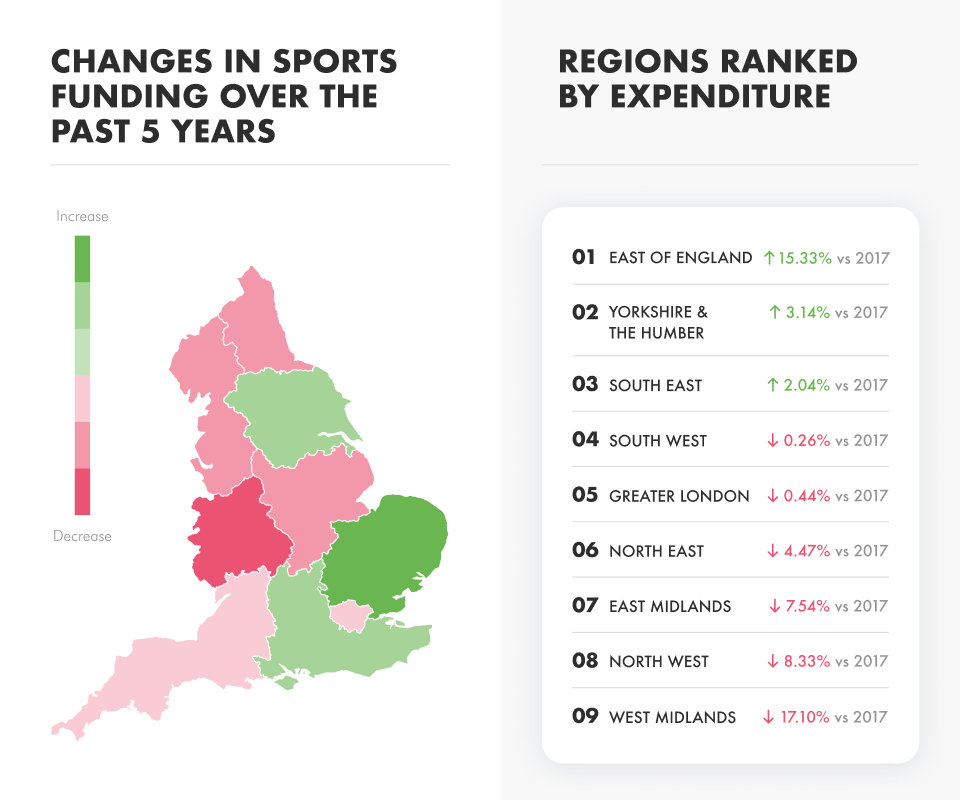England’s Sports Accessibility Index
According to the most recent UK health survey, about a third of men and just under half of women are not active enough to stay healthy. As a result, physical inactivity is estimated to cost the UK around £7 billion each year. Here at Runners’ Need, we want everyone to reap the benefits and joy of keeping active, but we also know that sport and physical activity is not equally accessible to everyone.
So in response to this crisis, we launched a study to examine how much town and city councils across England have invested into local sports and activity schemes over the past five years and which places have the best access to sports facilities. By comparing this to physical activity and wellbeing data, our tool allows you to check out how your area really ‘shapes up’.
What does our research tell us about English sports accessibility overall? On average, a town or city has 73 listed sports facilities per 100,000 people and spends £35.70 per head per year on sports funding. Over the last five years, sports expenditure has increased by 3.95% nationwide but over the same time period, physical activity rates have dipped by 1.5%.
Although this seems like a marginal change, this differs wildly from region to region. For example, since 2016, towns and cities in the East of England increased funding by 15% whilst on the other side of England in the West Midlands councils decreased their expenditure by 17% in the same period.
So, with such varying results up and down the country, we shine a light on the English towns and cities which make it easiest for residents to get involved and active (and which towns need to step up their game). Where does your town rank?
The top-scoring towns and cities
The only town to score in the top 10 for both sports facilities and funding is the Suffolk town of Ipswich. With 115 sports facilities per 100,000 residents (the 10th highest per person in the study) and a sports expenditure of £67.82 per person (the 8th highest spend), the town is awarded the study’s top spot when considering both factors. Surprisingly, despite these impressive stats, Ipswich has seen a -14.8% decline in physical activity rates since 2016.
In second place is Chesterfield in the East of Midlands. Nestled between Sheffield and Derby, Chesterfield has 137 local facilities per 100,000 residents and an average spend of £57.59 per person per year. Completing the top three is Crawley in West Sussex which despite a smaller number of facilities (with 84 per 100,000 locals) budgeted a whopping £114.45 per head – the biggest spend on sports expenditure per capita in the study.
But which councils leave the most room for improvement? Northampton, Solihull, and Braintree come bottom of the study.
The biggest sports spenders
It’s no surprise that cumulatively, the bigger cities like London, Leeds, and Birmingham are investing the largest sums into sports, play, and parks. But per person, which councils are putting sport at the top of the agenda?
Per head, the biggest spenders are Crawley, Gateshead, and Stevenage. Crawley’s spend of £114.45 is a sizeable 221% above the study average, Gateshead’s spend of £88.59 is 148% above average and Stevenage’s £85.56 is not far behind at 140% above average.
But not all counties have the same priorities. In 2020 and 2021, Northampton’s sports expenditure was just £4.28 per head, the least in the study. Faring a little better were Gloucester (£5.34) and Barnsley (£5.65).
But since 2016, it’s clear that sports expenditure strategy has radically changed in some towns and cities. Winchester’s spending has increased 128%, Exeter’s by 113%, and Derby’s 77%. But in other towns and cities, big cuts have been made to sports budgets. Redditch decreased its spending by 84%, Preston by 63%, and Swindon by 60% in the same period.
The best places for sports facilities
From leisure centres and grass pitches to tennis courts and bowling greens, having a variety of sports facilities in your area makes it easier to keep active, try out new sports and meet people to keep fit with.
But per population, which towns and cities have the most listed sports facilities? With 460 facilities per 100,000 people, Manchester ranks top by a long shot, with Nottingham trailing behind in 2nd place with 270 and Cambridge ranking 3rd with 181.
On the flip side, some areas leave locals with limited options. With 17 and 19 listed facilities per 100,000 residents respectively, Salford and Bournemouth give residents little choice, with Dudley, Northampton, and Basildon all performing equally poorly with a score of 23.
Using the tool, users can also compare how sports facilities and spending compares to local physical activity and well-being rates. Winchester, which has seen the biggest increase in sports expenditure, also has the highest physical activity rate in the study, at 76.4%. Oxford, Cambridge, and Exeter, which report the next highest physical activity rates, all scored in the top 10 when taking into account both sports expenditure and access to facilities.
But regardless of where your local town or city ranks, we hope this tool encourages residents, local sports businesses, and councillors to get out there and make the most of what’s on offer or be inspired to make a change and advocate for a more active lifestyle in your local community.



